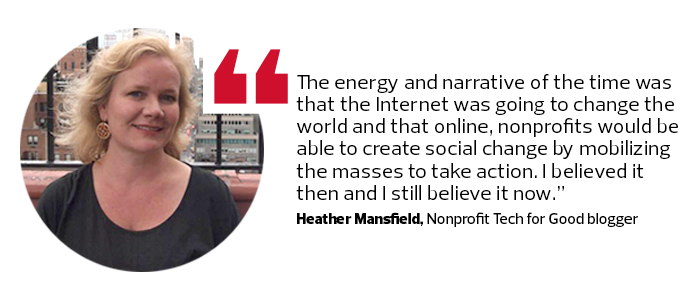Q&A: Heather Mansfield Is Ready for Nonprofit’s Mobile, Digital Future
It was a long, long time ago, in what seems like a galaxy far away, but do you remember when Myspace felt like the cutting edge of Internet innovation? It was 2005, and the world, it seemed, was in the midst of a Myspace revolution. In this dizzying time of friend requests and top 8 lists, Heather Mansfield, the woman behind the Nonprofit Tech for Good blog, began to truly connect the dots when it came to nonprofits’ potential to tap technology to support their missions. Now she has two decades of experience to share about working with nonprofits on their communication technology strategies.
Her blog is one of the 25 Must-Read Nonprofit IT Blogs BizTech recognized this year. We caught up with Mansfield to pick her brain on her past experiences with nonprofit tech, to get her take on where things are headed and to learn what inspired her to get involved with nonprofits and technology.
BIZTECH: What sparked your interest in covering nonprofits and technology?
MANSFIELD: I came of age when nonprofits were launching their first websites and we were all amazed by using email for the first time, not to mention the launch of the first online “Donate Now” button. The energy and narrative of the time was that the Internet was going to change the world and that online, nonprofits would be able to create social change by mobilizing the masses to take action. I believed it then, and I still believe it now.
But I also remember that the tech experts of the time would use jargon and tech speak that was incomprehensible to the average nonprofit communicator. Technology was not as easy to use back then as it is now, and a lot of nonprofit communication and fundraising staff – myself included – enthusiastically struggled to effectively pioneer these new communication and fundraising tools, but with little guidance.

Flash-forward to 2005 when I signed up for Myspace and began using the social network to promote nonprofits. I started receiving questions from nonprofits on Myspace about how to embed a video or use HTML to add an image into their bio. So I launched an email newsletter to provide easy-to-understand Myspace tips based on my own experience of not getting easy-to-understand tech advice in the late 1990s and early 2000s.
Then something completely unexpected happened: I started using Facebook (facebook.com/nonprofitorgs) and then Twitter (twitter.com/nonprofitorgs), and my email list grew, and then nonprofits started asking me to help with their social media campaigns, trainings or webinars, and then it was suggested that I start a nonprofit technology blog, which I did in 2011 (nptechforgood.com).
BIZTECH: Which technologies do you think are most important for nonprofits to consider using today?
MANSFIELD: I am still very bullish on websites, blogging, email and Donate Now buttons. I have seen Myspace come and go, Facebook evolve down to a reach of 2 percent. What stays steady and dependable are the core tools. However, those core tools have changed dramatically. Websites need more visual content and must be mobile-friendly. Emails should be short, visual, mobile and link to a good story on your website or blog.
The truth is, I cannot in good conscience tell a nonprofit to expand to Instagram or Periscope if they are still struggling with the basics. Those nonprofits need to prioritize investing time and money in their website and email campaigns first, but for those nonprofits that have invested in the future – which requires buy-in from executive staff – my advice is to shift into real-time storytelling and that requires mastering your smartphone for live photo and video recording, editing and streaming.
It requires adopting a new skill set and having the creativity to then compile and integrate the live content as recorded content into your website, blog posts, email newsletters and fundraising campaigns. It’s not easy. There’s a steep learning curve, but it’s fun and fresh, and it is what makes an exceptional online campaign stand out from the average.
BIZTECH: Who are some nonprofit innovators (organizations or people) that you look to for inspiration?
MANSFIELD: One example is the African Wildlife Foundation. Five or six years ago, they first caught my attention and I donated to them, but they weren’t very good at social media at the time, and then within the last few years they’ve transformed. It’s not just that they have great animal photos but that the photos are the correct size and they share them at the right time and in the right way on different social networks.
Female hartebeests are often accompanied by as many as four generations of their young. #AWFfacts pic.twitter.com/YN46lS8LVT
— AWF (@AWF_Official) March 30, 2016
They tapped in early to the power of infographics and using stats or inspirational quotes on images to trigger a like or a retweet. Their website and email newsletter redesign was almost perfect at the time of launch, and just recently they released a web-based annual report for 2015 that every nonprofit – no matter the cause they advocate for – can study and learn from.
Other nonprofits that are exceptional online are the Global Fund for Women, the Audubon Society and the National Parks Conservation Association. And those are just a tiny selection of nonprofits in the United States.
As far as people that I admire as being innovators, Craig Newmark of Craigslist comes to mind. He gave me advice in 2001 to always answer email promptly, and I think that’s very good advice. Good email etiquette is so important – even in these peak days of texting, snapping and tweeting – and it’s advice that I have mostly stuck by, but just last year I did have to put a disclaimer on my website that I cannot respond to all email, and that was a huge deal for me – to break the email creed.
I also admire many of the Gen X nonprofit tech pioneers at TechSoup. Ben Rattray of Change.org hired me remotely before that was common and helped me transition from a Change.org contractor to being 100 percent self-employed. Beth Kanter gave me great advice back in the early Myspace days to not put content behind walls but to make it freely available, and that is advice that still stands true today. Microsoft Citizenship Asia Pacific contracted me to travel and train NGOs all over Asia Pacific for four years. The experience showed me that some corporations donate a lot of money and do a lot of good in the world, and it made me a much better trainer – to personally understand and experience the geographical differences in nonprofit technology adoption.
BIZTECH: With fundraising moving more to the digital space with the rise of crowdfunding platforms, what do you think is right and wrong with modern online fundraising?
MANSFIELD: Crowdfunding has been utilized in the nonprofit sector since 2000 with the launch of DonorsChoose.org and 2002 with the launch of GlobalGiving. It worked then, it works now, and will continue to work for years. Nonprofits need to learn how to write, record and effectively promote crowdfunding campaigns. Online fundraising is growing and could easily make up 20 percent of a nonprofit’s operating budget by 2025 (it’s 9 percent now), so again, having a top-notch Donate Now page and online thank-you process is crucial and having fundraising staff that understand crowdfunding is an essential investment.
That said, what I am most excited about is the rise of digital payments inside Facebook, Twitter, Instagram, YouTube, Snapchat, et cetera, as well as the increasing likelihood of in-app donations through Apple Pay and Android Pay. The skeptics of social media fundraising either don’t know about digital payments and mobile wallets or have no vision.









